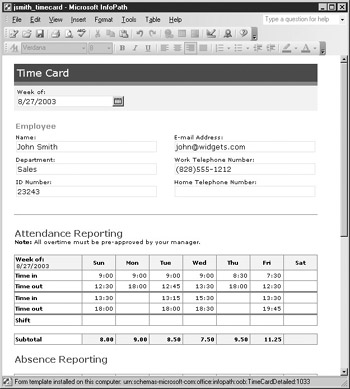Chapter 1: Introducing InfoPath
How to…
Overview
-
Understand the components of an XML document
-
Understand how InfoPath is used
-
Install InfoPath on your computer
InfoPath 2003 is the newest member of the Microsoft Office System and has been designed to capture and consolidate information traditionally gathered using paper-based forms or other electronic documents such as Excel spreadsheets, Word documents, and so on. Using InfoPath, you can create feature-rich electronic forms that can be used to gather information from users. InfoPath then enables you to reuse that information in a wide variety of systems and applications.
So, what does an InfoPath form look like? Figure 1-1 shows a typical InfoPath form that is designed to gather employee time-card information.

Figure 1-1: An employee time-card form
Like traditional paper-based or electronic documents, InfoPath forms can be designed to capture any information you require. The difference is that the information entered in an InfoPath form can be tied to a back-end system or database, thereby eliminating the need to retype information into disparate systems through extensive use of XML, XML Web Services, and direct database connections. The following sections look at some of the different ways that you can use InfoPath and introduce you to some of the key components and technologies that make InfoPath work.
EAN: 2147483647
Pages: 142